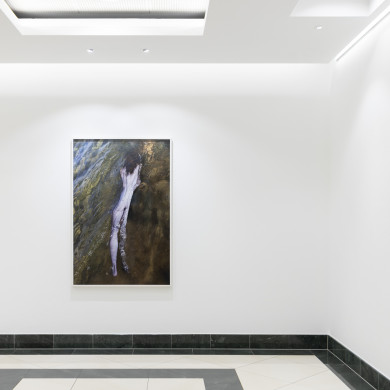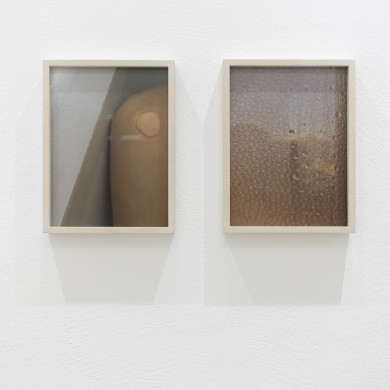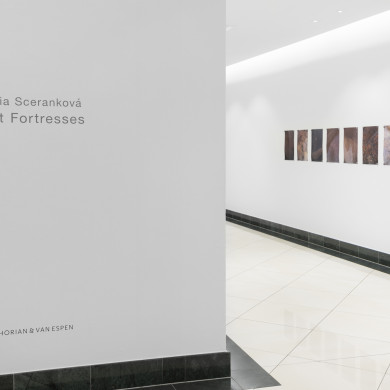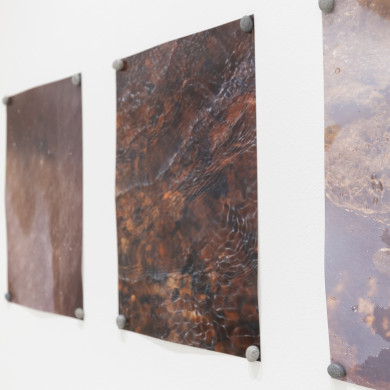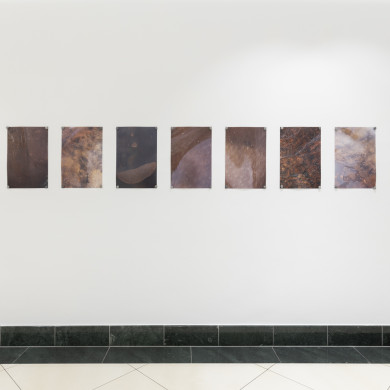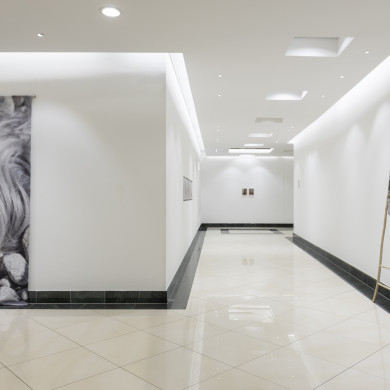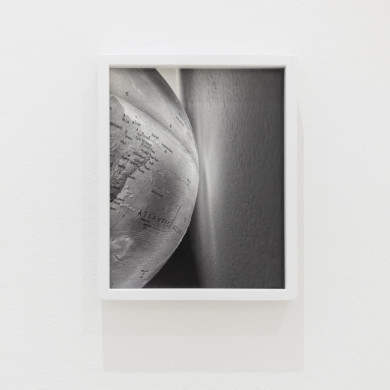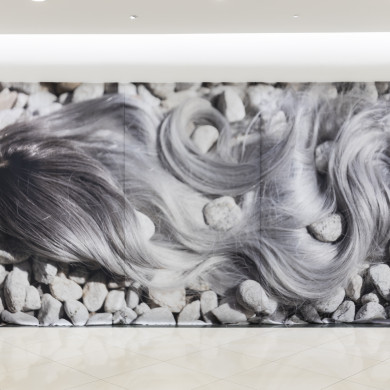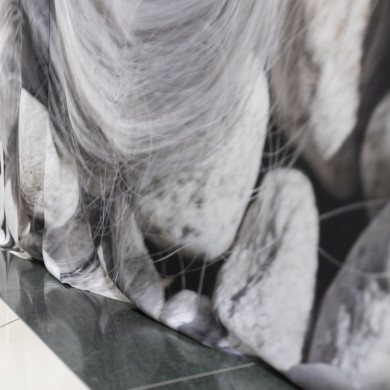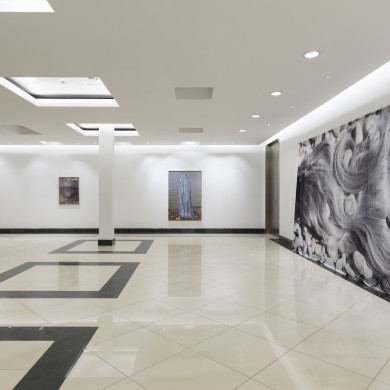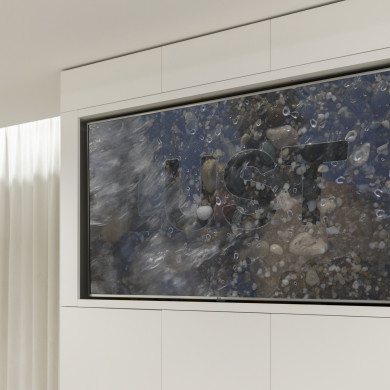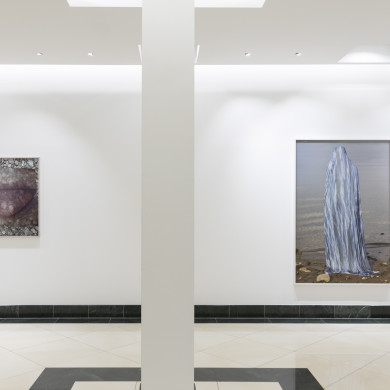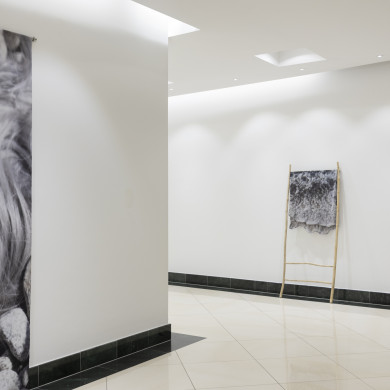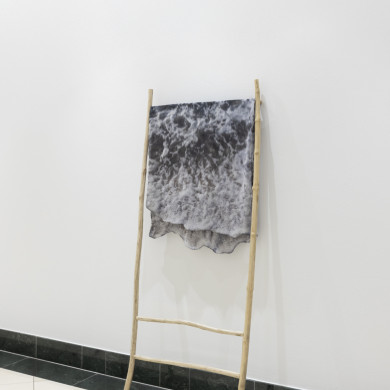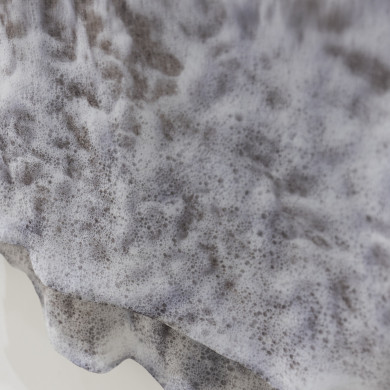Lucia Sceranková | Soft Fortresses
25 June – 12 Sep 2025
ZAHORIAN & VAN ESPEN, Carlton Savoy, Bratislava
“Everything the heart desires can always be reduced to the form of water.”
—Gaston Bachelard
In his “Water and Dreams” text (1942), French philosopher Gaston Bachelard perceives water as the most dynamic natural force—one that triumphs over the austere dryness of fire. He even attributes to it a feminine, almost maternal character: we constantly see it being born and growing, falling, waving, floating, and swaying. It softens and nourishes everything around it, which is why he calls it “the milk of all mothers – the mother Nature.” In her exhibition project Soft Fortress, Lucia Sceranková explores the processes and mechanisms of embodiment and disembodiment within the photographic image. She is particularly interested in the connection between the human body and mind with the non-human world, a world with which we naturally intertwine through the landscape and its elements.One of the most visually powerful natural elements, with its untamed energy, is water, which forms the central motif of the current exhibition.
The artist visualizes physical contact with water and earth through the lens of sensory experience, especially touch and taste. Unsettling motives, such as a mouth or a wavy wig left on a rocky shore, metaphorically allude to an unsurpassable desire to live. The concepts of desire and fragility are also emphasized in the conceptual level of the work, where the artist allows a textual model to be washed by ocean waves. At the same time, the images subtly suggest the relentless passage of time and the act of disappearance. From the depths of a lake emerges the silhouette of a female figure draped in a shimmering watery veil. And it is just as possible that she is submerging into it. This is Mara, the personification of the Liptovská Mara, a water reservoir which still holds, within its depths, submerged villages, cemeteries, and the stories of those who didn’t want to abandon their land. Also in Bachelard’s writing, water is an object of dreaming, melancholy, and death. For him, a homeland is not defined by its expanse, but rather by a certain substance tied to a place. Thissubstance could be anything from soil to water. “To vanish in deep water or to disappear on a distant horizon, to merge with the depths or with the infinite such is the human fate, the image of which is the destiny of water. ”
Water can also be understood as an effective metaphor for the photographic surface, which often functions as a permeable and fluid interface, with its own specific dynamics. A continuous thread in the artist’s work is the exploration of the emotional resonance of an image in relation to the physical qualities of the materials used. Here, we encounter photography in its classical form, but also as a materialized object or animated in moving images. The ephemeral aspect of text enters the image, striving to merge with it. But also the reverse happens – the motif of the sea wave emerges from the image and becomes independent in the form of a cascading fabric. Even a soft image can remain firm. “Water thus appears to us as a complete being: it has a body, a soul, a voice. Perhaps more than any other element, it represents a fully poetic reality.” / Lucia L. Fišerová
BACHELARD, Gaston. Water and Dreams.
Lucia Sceranková | Soft Fortresses
25.6. – 12.9. 2025
ZAHORIAN & VAN ESPEN, Carlton Savoy, Bratislava
„Všechno, po čem srdce touží, lze vždy redukovat na podobu vody.“
Gaston Bachelard
Francúzsky filozof Gaston Bachelard vo svojom texte Voda a sny (1942) vníma vodu ako najdynamickejšiu prírodnú silu víťaziacu nad strohou suchosťou ohňa. Prisudzuje jej dokonca ženský, až materský charakter: neustále ju vidíme rodiť sa a rásť, padať, vlniť sa, nadnášať a kolísať. Zmäkčuje a vyživuje všetko naokolo, preto ju nazýva tiež „mlékem matky všech matek – matky Přírody“. Lucia Sceranková vo svojom výstavnom projekte Mäkké pevnosti sleduje postupy a mechanizmy stelesnenia a odtelesnenia vo fotografickom obraze. Autorku zaujíma predovšetkým prepojenie ľudského tela a mysle s mimoľudským svetom, s ktorým sa prirodzene prelíname v prostredí krajiny a jej živlov. Jedným z vizuálne najsilnejších prírodných elementov je so svojou nespútanou energiou práve voda, predstavujúca ťažiskový motív aktuálnej výstavy.
Autorka vizualizuje telesný dotyk s vodou a zemou v kontexte zmyslov, predovšetkým hmatu a chuti. Znepokojujúce motívy úst a vlnitej parochne pohodenej na kamenistom pobreží metaforicky odkazujú k neprekonateľnej túžbe žiť. Pojmy túžby a krehkosS sú akcentované taktiež v rovine konceptu, kedy autorka necháva textový model obmývať morskou vlnou. Zároveň však v obrazoch vnímame určitú náznakovitosť neúprosného plynutia času a miznutia. Z hlbín jazera vystupuje silueta ženskej postavy v trblietavom vodnom závoji. A rovnako možné je, že sa doň vnára. Je to Mara, personifikácia liptovskej priehrady, ktorá vo svojich útrobách stále drží zatopené dediny, cintoríny, aj príbehy obyvateľov, ktorí svoje pozemky opustiť nechceli. I v Bachelardovom texte je voda zároveň predmetom snenia, melanchólie a smrti. Podľa neho rodný kraj nepredstavuje rozlohu, ale skôr istú hmotu spätú s daným miestom. Môže ňou byť čokoľvek, od pôdy až po vodu. “Zmizet v hluboké vodě nebo zmizet na vzdáleném obzoru, splynout s hloubkou nebo s nekonečnem, takový je lidský osud, jehož obrazem je osud vody.”
Vodu môžeme súčasne chápať aj ako účinnú metaforu fotografického povrchu, ktorý často funguje ako priepustné a tekuté rozhranie so svojou špecifickou dynamikou. Kontinuálnou súčasťou autorkinej tvorby je skúmanie emočnej rezonancie obrazu v kontexte fyzických kvalít použitého materiálu. Fotografiu tu nachádzame v jej klasickej podobe, ale i materializovanú – v podobe objektu či zdynamizovanú v pohyblivom obraze. Efemérna zložka textu vstupuje do obrazu v snahe splynúť s ním, ale i naopak – motív morskej vlny z neho vystupuje a osamostatňuje sa vo forme prevísajúcej textílie. I mäkký obraz môže zostať pevným. „Voda se nám tak jeví jako celistvá bytost: má tělo, duši, hlas. Možná více než kterýkoli jiný živel představuje úplnou básnickou skutečnost.“/ Lucia L. Fišerová
